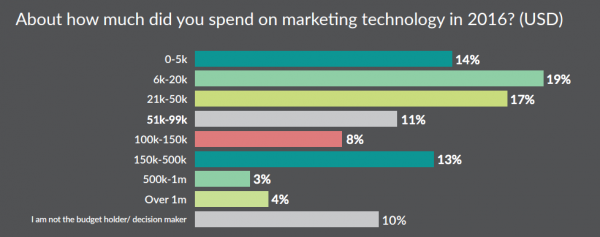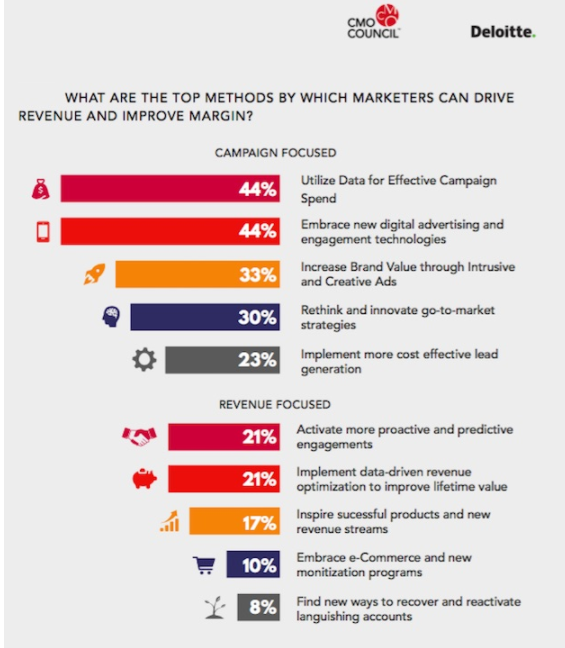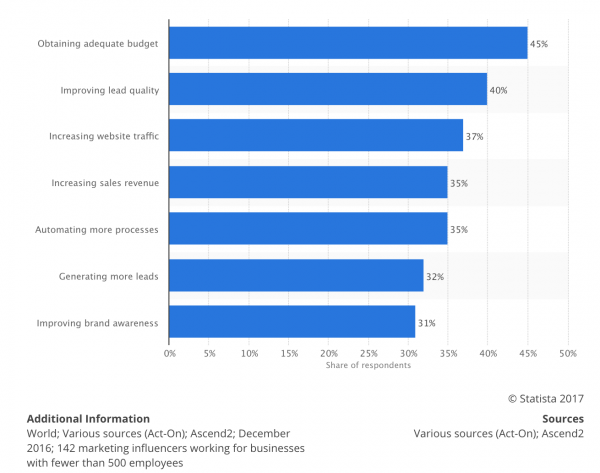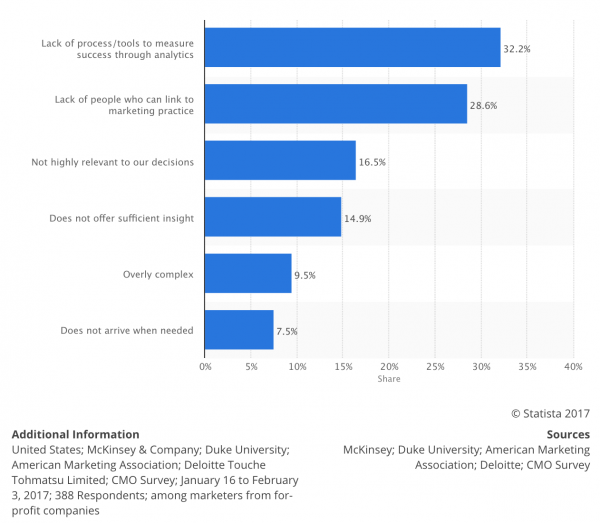
Marketing executives can no longer complain that that data derived from marketing technology lacks actionable insight. Instead, with the majority of CMOs embracing new and fast-evolving marketing tech, the outsized concern is feeling overwhelmed due to the amount of data available today. This blog considers top strategies to manage data overload in 2017.
“82% of marketing execs introduced 1 to 5 new technologies in 2016, but 53% say they feel ‘overwhelmed’ by the amount of data in their marketing technologies.” — Conductor, 2017.
In Conductor’s 2017 survey of marketing executives, 38% used 6 - 10 marketing technologies — including automation, social tracking, SEO tools, workflow managers and more. Some 7% even reported more than 20 different software solutions!
These software solutions represented quite the investment as well:

CMOs are under greater pressure than ever to drive revenue and improve margins, and they see data as one of the top methods for impacting those measures, according to a CMO Council report.

“As a B2B marketer, when you think of data, you should see your customers. Data analytics tells us who our buyers are, what they’re interested in, what pain points they have, and what they need from a product or solution.” — Salesforce Pardot
With SMBs, the barriers to digital marketing success beyond gaining the right budget are often interrelated and can be greatly enhanced by gaining deeper and more actionable data insights.

Move away from purely manual analysis and adopt data-driven practices from marketing automation. Only 27% of marketers using primarily manual data processes with their data find their metrics are consistent across the organization, according to the Harvard Business Review. Yes, identifying the best combination of analytical acumen and creative skills can be challenging, but accurately tracking, storing and managing all of the data insight available today demands effective leverage of marketing technology. Marketing automation allows for creating snapshot reports and dashboards that drill down to more meaningful and substantive insights quickly. This allows marketing leadership to act on insights with greater efficiency.
Related reading: Blog Metrics for Marketing Success
Align sales and marketing. To put data to best use, share data sets across the organization — even including the C-suite — to track performance and ROI and identify successful strategies and provide valuable insights that can benefit the organization as a whole. Much of the failure of modern day marketing and sales exist at between the two departments.
If marketing and sales work together, revenue could grow upwards of 10% annually via @IDC via @HubSpot.
Benchmark data. Accurate analysis of data requires digging into past performance to best measure future success. For many marketing teams, campaign failures exist because they don't truly understand their historic benchmarks. Instead, executives try to force marketing teams to live up to "industry standards," which are taken out of context, arbitrary in nature and don't accurately apply to the organization.
Setting appropriate benchmarks involves identifying metrics that relate to business success and align well with business goals. Taking the time to dig into conversion rates, lead acquisition tracking, lead management, conversion factors, and more measures of engagement can help identify new opportunities and what is working or needs to be fixed.
“Marketing leaders are 3x more likely than laggards to use data for their decisions.” — Invoca
Establish standards. With so much data to manage, it pays to verify the value and accuracy of the data from the outset. In order to establish strong standards in reporting and measurement, executives need to trust the baseline for such reporting. You don’t want to waste time poring over data sets only to determine that the resulting strategic planning was founded on poor quality data. Spend an appropriate amount of time early on to provide context, evidence, and the right level of due diligence in data gathering activities--especially when setting baselines.
Using arbitrary metrics or unaligned processes can cripple marketing teams that are pushing for success. The chart below shows data on the common obstacles to marketing analytics usage. Identifying valuable metrics and measurement practices will speed up insights, executive buy in, and marketing team alignment.

Look broadly and test assumptions. With marketing technology today it is easier to develop multichannel metrics, track data from other sources and customize dashboard views to determine what you need to measure for a particular campaign. Further, with insights into marketing efforts on many channels, you’ll be better able to spot success and take out the efforts that your buyers see as bombarding them with messaging. Avoid making assumptions that X channel or Y strategy doesn't work based purely on personal experience. Run tests early in campaign initiatives to identify great sources, insights, and approaches.
Examples of tests could be:
Ok, so where does this data come from? It depends entirely on your business and sustainability model, but there can be some great starting points. Below is chart of data sources used in marketing based on a survey from Econsultancy andInternational Business Machines Corporation in the United States as of November 2016.
Drill deeper. As much as today’s "martech" enables a wide view, use the benchmarking of KPIs to identify where you need to dig deeper into the data. Taking a closer look into campaign specifics can shape the overall success of your inbound marketing strategy. For example, with data analysis today it’s much easier to examine metrics indicating which of an A/B test email had a better response or what header or image prompted a greater response. But don't end there, continue the testing process to drill deeper into your testing practice. Take the winners of A/B testing and pit them against more creative options. Continue to test against creative or data-based options in order to
But don't end there, continue the testing process to drill deeper into your testing practice. Take the winners of A/B testing and pit them against more creative options. Continue to test against creative or data-based options in order to gain an edge against the competition. Companies that are agile, adaptive, and experimental will lock in on leading opportunities and steal market share.
The amount of data available today is staggering. IBM’s Jeremy Waite suggests “many data analysts are suggesting the digital universe will be 40 times bigger by 2020!” The answer, then, to handling data overload is not capturing ever more leads and email addresses. Instead, it’s getting smart about how we analyze all our existing data.
Sources
Conductor. (2017). Marketing Executives Reveal Their 2017 Marketing Strategy. https://ww2.conductor.com/rs/149-ZMU-763/images/Marketing-Execs-Reveal-Their-2017-Marketing-Strategy.pdf
CMO Council. (2016, December). The CMO Shift to Gaining Business Lift: Executive Perspectives. https://www.cmocouncil.org/authority-leadership/reports/320
DemandGen. (2016). Modern Marketing Maximized: 5 Key Steps for Data-Driven Success. https://www.demandgenreport.com/resources/white-papers/modern-marketing-maximized
Gonzales, C. (2017, January 6). 5 Themes CMOs Need To Focus On In 2017 [Infographic]. https://blog.invoca.com/5-key-themes-cmos-need-to-focus-on-in-2017/
IBM Marketing Cloud. (2017). 10 Key Marketing Trends for 2017 and Ideas for Exceeding Customer Expectations. https://www.silverpop.com/Landing-Templates/1-GLOBAL-IBM/NA-IOT/US-IMT/2016/2017-marketing-trends
IBM Watson Marketing. (2016, December 7). Tips for Navigating the Dark Marketing World. https://www.youtube.com/watch?v=uToIdlq4EZQ
Salesforce/Pardot. (2017). B2B Marketers Guide to Data Analytics: The 3-Steps to Become a Data-Driven Marketer.
Special thanks to Statista.
by Jonathan Franchell, CEO of Ironpaper - For more tips and hacks: Need to remove a new line after h1 tags? Both web designers and SEO practitioners need to employ headline tags: H1, H2, H3 in several ways to improve web page structure and tag...

The marketing industry is transforming significantly due to generative AI and increasing market complexity. Gartner's prediction of a 25% decline in traditional search traffic suggests that the era of search engines is dying. AI tools, particularly...

The Crowded Arena of the IT Marketplace Updated December 2024 The Information Technology (IT) landscape is experiencing rapid growth and intensifying competition. IT spending is projected to reach nearly 5.1 trillion U.S. dollars in 2024, a...

Updated December, 2024 The field of digital marketing is evolving rapidly in response to new technology and changing buyer expectations. To help career-minded marketers, we’ve rounded up the top 10 skills needed to succeed in the field. These are...
